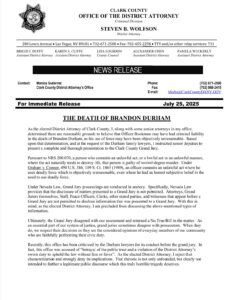Great State of Nevada
July 28, 2025
INTRODUCTION
Nevada’s justice system is founded on the principle that all individuals are equal under the law. But when it comes to police accountability, the state’s grand jury process tells a different story—one of secrecy, selective evidence, and a systemic bias favoring law enforcement. The public rarely sees it, but for decades, Nevada’s grand juries have functioned not as tools of oversight, but as shields for officers under scrutiny.
A deep dive into how these juries are formed, who governs them, and how their proceedings unfold reveals a system designed to protect power, not challenge it.
What Is a Grand Jury and How Is It Formed in Nevada?
A grand jury is a body of citizens—usually 16 to 23 people—empaneled to determine whether there’s enough evidence to formally charge someone with a crime. Unlike trial juries, grand juries do not decide guilt or innocence. They decide whether a criminal case should proceed to trial based on “probable cause.”
How Are They Selected?
Grand jurors are selected from the same general jury pool as trial jurors, which comes from voter registrations, driver’s licenses, and ID cards. However, their selection is overseen entirely by the court and the prosecutor’s office. Judges appoint the foreperson, and prosecutors control what cases are presented, what evidence is shown, and which witnesses are called.
In Clark and Washoe Counties, a standing grand jury is convened for weeks or months at a time, often hearing dozens of cases. Police-involved shootings or misconduct investigations, when they reach a grand jury at all, are handled within this insulated system.
Mission Statement and Legal Framework:
While Nevada grand juries do not have a formal “mission statement,” their purpose is codified in Nevada Revised Statutes (NRS) Chapter 172, which grants prosecutors broad powers regarding the use and timing of grand juries. Under the law:
• A grand jury may return an indictment if it finds probable cause.
• It is not required to hear from the target of the investigation.
• Proceedings are held in secret (NRS 172.245).
The original intent behind grand juries was to act as a buffer between the government and the citizen, protecting people from unwarranted prosecution. However, in practice, Nevada’s laws give prosecutors and police disproportionate influence over what the jury sees and what it doesn’t see.
Why Are Grand Jury Proceedings Secret in Nevada?
Nevada law mandates strict secrecy in grand jury proceedings (NRS 172.245–172.255). This includes:
• Sealed transcripts.
• Closed-door hearings.
• Gag orders on witnesses and jurors.
The stated reasons for secrecy include preventing witness tampering, protecting the accused if not indicted, and encouraging frank testimony. But in practice, this secrecy benefits law enforcement disproportionately. When an officer is accused of misconduct—especially in cases of deadly force—prosecutors can control the narrative without public scrutiny.
In high-profile cases, this secrecy is weaponized. Families of victims, civil rights attorneys, and the media are locked out, while the grand jury quietly decides if an officer will be charged—almost always choosing not to.
How Law Enforcement Influences Nevada Grand Juries:
1. Prosecutorial Control
Police and prosecutors work hand-in-hand. District Attorneys in Nevada often rely on police for investigations, courtroom testimony, and future cases. This relationship makes it highly unlikely that a DA will aggressively pursue charges against an officer.
Prosecutors decide:
• What evidence the jury sees.
• How it’s presented.
• Whether expert witnesses or use-of-force analysts are brought in.
And there is no cross-examination. No defense attorney. No judge moderating. Only the DA and the narrative they build.
2. Selective Evidence
Grand juries are only presented with evidence that supports the DA’s interpretation of the case. Exculpatory or critical evidence may be downplayed or ignored entirely. In police cases, video evidence (e.g., bodycam) may be shown without context—or not at all.
3. Police Testimony Given Extra Credibility
When officers testify, they are often treated as expert witnesses. Their training, experience, and “split-second decision-making” are emphasized. Civilian witnesses, by contrast, are often painted as unreliable or uninformed. The jurors—everyday citizens—are likely to defer to law enforcement as the authoritative source.
The Data Doesn’t Lie:
In Nevada, police rarely face indictment for use-of-force incidents, even when there is strong public outcry. The grand jury is often where those cases quietly disappear.
Across the U.S., a 2015 report by the Washington Post found that grand juries indicted less than 1% of officers involved in fatal shootings. Nevada fits that trend.
The use of grand juries in police cases may serve as a political shield for elected DAs. If the public demands accountability, prosecutors can say, “The grand jury decided,” while never admitting that the jury only saw what the DA showed them.
A Call for Reform:
Critics across Nevada, from civil rights advocates to former judges, have long called for reform:
• Make police use-of-force cases go through preliminary hearings, where the public and press can see the evidence.
• Allow civilian review panels or independent prosecutors to present cases involving police.
• End the blanket secrecy of grand jury transcripts when officers are not indicted.
• Educate jurors about their right to ask for more evidence or refuse to indict if they feel manipulated.
Conclusion: Justice Hidden from View:
Nevada’s grand jury system was designed to act as a safeguard. Still, when it comes to holding police accountable, it’s become a fortress—shielding law enforcement behind closed doors, selective evidence, and unbreakable secrecy.
Until the laws are restructured and the process opened up, the citizens of Nevada will continue to see justice delivered behind a curtain—especially when the accused wears a badge.
Sources:
• Nevada Revised Statutes Chapter 172
• Clark County District Attorney’s Office Public Records
• American Civil Liberties Union of Nevada
• National Police Accountability Project



